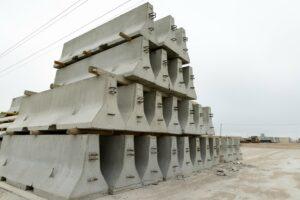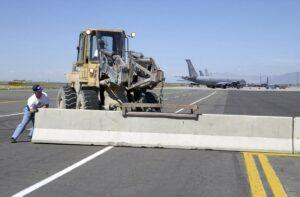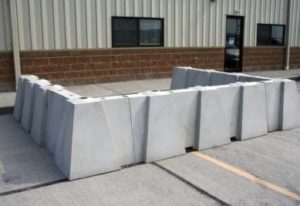Water-Filled Barriers vs. Concrete Barriers: Which One is Safer?
If you’re shopping for new or used barriers, chances are you’ve come across the option of water-filled traffic barriers. These are a popular option as they’re cheaper than traditional concrete barriers, but which one is the safest for your particular project?
The differences between these types of barriers are pretty extensive, so it’s important to assess the safety, durability, and overall effectiveness of each type. Here’s a guide to the pros and cons of each so you can make the right choice for your project.What are Water-Filled Barriers?

Water-filled barriers, often made of high-density polyethylene (HDPE) plastic, are a common choice for temporary construction projects and safety measures. These types of barriers are lightweight and portable. They’re relatively easy to transport and install, making them suitable for short-term projects where mobility is crucial. Setting up water-filled barriers is typically a quick process, allowing for rapid setup when needed.
Here’s a closer look at their characteristics:
Pros of Water-Filled Barriers
- Can be used filled or empty
- Highly visible due to their bright color options available
- Lightweight model means lower transportation costs
- Can be placed without machine or forklift
- Easy to position and reposition
Water-filled barriers are typically less expensive upfront compared to concrete options, making them an attractive choice for budget-conscious projects. However, there are some significant downsides to choosing these over the conventional concrete option.
Cons of Water-Filled Barriers
Without the durability of concrete, plastic water-filled barriers are more susceptible to damage from UV exposure and extreme weather conditions, potentially reducing their lifespan. They can be unstable in some conditions, too, and can be knocked over by strong winds.
- Less durable than concrete barriers
- Cost is similar or more expensive than concrete barriers
- Less effective in withstanding high-speed impacts and may rupture, compromising safety
- Easy for trespassers to break
- Leaks may happen, especially when buying used water-filled barriers
- Can pose safety issues to passing vehicles if moved during strong winds
With their limited impact resistance and occasional instability, many people choose not to take the risk of using water-filled barriers for traffic purposes. Let’s take a look at when concrete barriers might be the better choice.
When To Choose Concrete Barriers
K-rail barriers have been a staple in road and construction safety for many years because of their durability. Here are some reasons you might consider concrete barriers for your next project.

Pros of Concrete Barriers
- Strength and durability. Concrete barriers or K-Rail offer unparalleled protection against high-speed collisions, reducing the risk of vehicles breaching work zones.
- Longevity. These barriers are built to last, with a lifespan extending far beyond that of water filled alternatives.
- Stability. Highway barriers are heavy and inherently stable, providing a solid defense against gusty winds and accidental impacts.
- Customization. They can be customized to suit various applications, including crash-resistant designs for high-risk areas.
- Environmental considerations. Concrete barriers are environmentally friendly in the sense that they do not require ongoing maintenance, frequent replacement, or disposal, as is often the case with damaged or worn-out water filled barriers.
While concrete barriers are typically the superior choice, there are a few cons to take into consideration before purchasing.
Cons of Concrete Barriers
As mentioned before, jersey barriers typically have a higher upfront cost compared to water-filled options, so temporary or short-term projects often choose water-filled plastic barriers instead. However, if you need your barriers to last as a long-term solution, the durability of concrete barriers offsets the upfront cost.
Another downside to mention is potential transportation challenges. Because of their weight, transporting concrete barriers may require specialized equipment.
Which One Should You Choose?
In the ongoing debate of water-filled barriers vs. concrete barriers, concrete usually wins with its comprehensive solutions for safety, longevity, and performance.
While water-filled barriers may have their place in specific applications, their limitations in terms of impact resistance, durability, and stability make them less effective overall.
Choosing the right barrier is paramount for protecting lives and property on construction sites and roadways. Concrete barriers tend to be the reliable choice for professionals who prioritize safety above all else.
Take Action for Superior Safety with 48 Barriers
At 48 Barriers, we specialize in providing top-notch concrete barriers, both new and used. If you need guidance while exploring your options, we’re here to help!
Contact us today via phone or email, or fill out a quick quote to get a cost estimate. Feel free to reach out with any questions – your project’s safety is our top priority.




